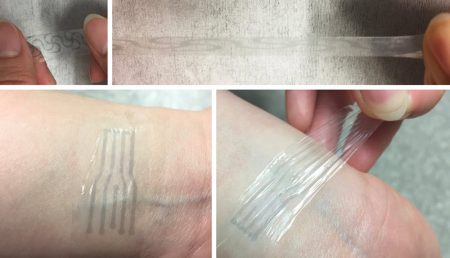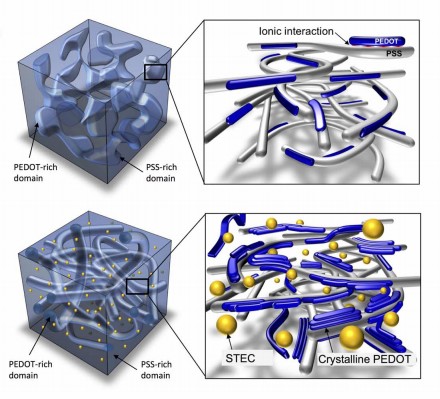March 13, 2017 – Chemical engineers at Stanford University have created soft, flexible plastic electrodes that can be stretched like a rubber band while maintaining the integrity of the internal wiring.
In a March 10 paper published in Science Advances, the inventors describe their success in creating “a highly stretchable conducting polymer.” that maintains its electronic integrity. The material used is polyethylenedioxythiophene:polystyrenesulfonate, which the inventors have shortened to the acronym PEDOT:PSS. To this polymer, the inventors added sodium salt compounds and ionic liquids, what they describe as stretchable electrical conductivity (STEC) enhancers which resemble additives used to thicken soups. It appears to have a fishnet molecular structure giving it the ability to deform without losing cohesion.
The appearance end result can be seen in the schematic appearing below with a fishnet molecular structure capable of deforming without losing cohesion. The top illustration shows the polymer prior to the addition of the STEC enhancers which alter the physical nature of the film as seen in the bottom illustration. The STEC enhancers are commercially available molecular compounds and liquids.
One of the most important features of this invention is its transparency. For example, it can be used in solar cells, lighting displays, consumer electronics, and clothing. But the team was thinking more about biomedical applications where elasticity and deformability fit. Yue Wang, one of the inventors, a postdoctoral research fellow, sees the technology being used for brain implants because it would conform to the plasticity observed in the brain as it “swells and de-swells” daily.
Currently a prototype, the Stanford team, led by Zhenan Bao, Professor of Chemical Engineering, continues to work in his Bao Lab on various polymers with high conductivity capability that can be spread on clear surfaces like “a knife spreading butter on toast.”










